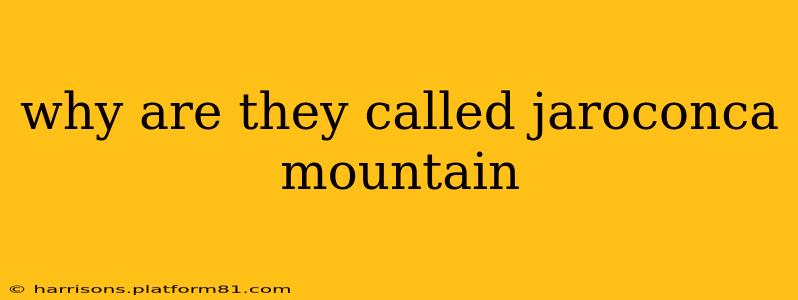The name "Jaroconca Mountain" likely stems from a combination of factors, reflecting the rich history and geography of the region where it's located. Unfortunately, without specifying the exact location of Jaroconca Mountain (there isn't a widely known mountain with this precise name), a definitive answer is difficult. However, we can explore potential etymological origins based on common naming patterns in mountainous regions:
Possible Origins of the Name "Jaroconca"
The name probably combines indigenous words or elements from colonial languages (Spanish or Portuguese, depending on the region) with descriptive terms related to the mountain's characteristics. Let's break down some possibilities:
1. Indigenous Language Roots: Many mountain names across the globe derive from the languages of the indigenous people who originally inhabited the area. The sounds "Jaro" and "Conca" might be remnants of words relating to:
-
Physical features: "Jaro" could relate to a characteristic of the mountain's shape, such as its height ("jarro" in some languages means "jug" or "tall vessel"), while "Conca" might refer to a valley or concave shape in the mountainside ("conca" in some languages meaning "shell" or "concave").
-
Flora and fauna: The words could describe prominent plants or animals found in the region. For example, a type of tree or bird unique to the area.
-
Spiritual or mythological significance: Mountains often hold sacred meaning in indigenous cultures. The name could reflect a deity, legend, or significant event associated with the mountain.
2. Colonial Influence: If the region was colonized by Spain or Portugal, the name could contain elements from these languages. "Conca" in Spanish/Portuguese already hints at the shape of the land. "Jaro" could be a corrupted or altered form of a Spanish or Portuguese word, or it might be a combination of syllables from different words.
3. Descriptive Elements: The name might be a descriptive term summarizing a prominent feature of the mountain. This could be its color, the type of rock it's made of, or even a notable landmark near it.
Understanding the Context is Key
To pinpoint the precise origin, we need additional information:
- Location: Where exactly is Jaroconca Mountain? Specifying the country and region will help narrow down the possible languages and cultural influences involved in its naming.
- Local History: Researching the history of the region, including indigenous languages and colonial influences, can provide crucial clues about the meaning of the name.
- Local Legends: Exploring local folklore and myths associated with the mountain might reveal interesting stories about its origin and naming.
Further Research
To find a definitive answer, consult local historical societies, archives, geographical databases, and potentially linguistic experts specializing in the languages of the region where Jaroconca Mountain is located.
By investigating these avenues, you stand a far better chance of uncovering the fascinating story behind the name of this mountain.
